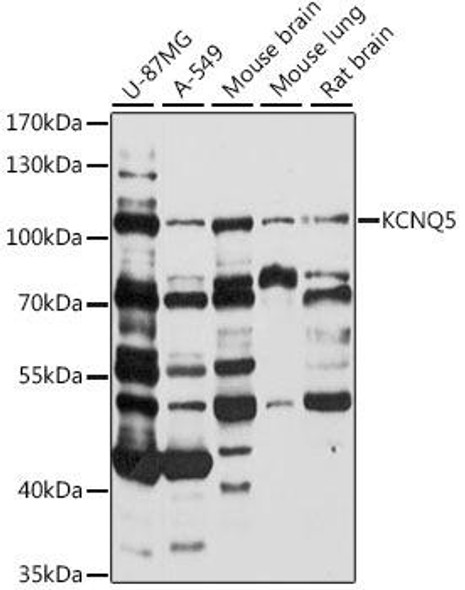Description
KCNQ2/KCNQ3/KCNQ4/KCNQ5 Antibody (PACO04167)
The KCNQ2/KCNQ3/KCNQ4/KCNQ5 Antibody (PACO04167) is a specialized tool for research involving potassium channels KCNQ2, KCNQ3, KCNQ4, and KCNQ5. These channels play crucial roles in regulating neuronal excitability and are implicated in various neurological disorders such as epilepsy and Alzheimer's disease. This polyclonal antibody, produced using state-of-the-art technology, is highly specific to the KCNQ2, KCNQ3, KCNQ4, and KCNQ5 proteins, making it an excellent choice for Western blot and immunofluorescence applications. It allows for the detection and analysis of these channels in different cell types and tissues, providing valuable insights into their function and potential therapeutic targets.
Studying the function of KCNQ2, KCNQ3, KCNQ4, and KCNQ5 channels is essential for understanding the mechanisms underlying neuronal excitability and how dysregulation of these channels can contribute to neurological disorders. This antibody is a valuable tool for researchers in the fields of neuroscience, neurology, and pharmacology seeking to advance our knowledge of potassium channel function and develop novel treatments for neurological diseases.
| Antibody Name: | KCNQ2/KCNQ3/KCNQ4/KCNQ5 Antibody |
| Antibody SKU: | PACO04167 |
| Size: | 50ug |
| Host Species: | Rabbit |
| Tested Applications: | ELISA, IHC |
| Recommended Dilutions: | IHC:1:100-1:300 |
| Species Reactivity: | Human, Mouse, Rat |
| Immunogen: | synthesized peptide derived from human KCNQ2/3/4/5 around the non-phosphorylation site of T217/246/223/251. |
| Form: | Liquid |
| Storage Buffer: | Liquid in PBS containing 50% glycerol, 0.5% BSA and 0.02% sodium azide. |
| Purification Method: | The antibody was affinity-purified from rabbit antiserum by affinity-chromatography using epitope-specific immunogen. |
| Clonality: | Polyclonal |
| Isotype: | IgG |
| Conjugate: | Non-conjugated |
| Synonyms: | KCNQ2; Potassium voltage-gated channel subfamily KQT member 2; KQT-like 2; Neuroblastoma-specific potassium channel subunit alpha KvLQT2; Voltage-gated potassium channel subunit Kv7.2; KCNQ3; Potassium voltage-gated channel subfamily KQT me |
| UniProt Protein Function: | Kv7.2: Probably important in the regulation of neuronal excitability. Associates with KCNQ3 to form a potassium channel with essentially identical properties to the channel underlying the native M-current, a slowly activating and deactivating potassium conductance which plays a critical role in determining the subthreshold electrical excitability of neurons as well as the responsiveness to synaptic inputs. KCNQ2/KCNQ3 current is blocked by linopirdine and XE991, and activated by the anticonvulsant retigabine. Muscarinic agonist oxotremorine-M strongly suppress KCNQ2/KCNQ3 current in cells in which cloned KCNQ2/KCNQ3 channels were coexpressed with M1 muscarinic receptors. Defects in KCNQ2 are the cause of benign familial neonatal seizures type 1 (BFNS1). A disorder characterized by clusters of seizures occurring in the first days of life. Most patients have spontaneous remission by 12 months of age and show normal psychomotor development. Some rare cases manifest an atypical severe phenotype associated with epileptic encephalopathy and psychomotor retardation. The disorder is distinguished from benign familial infantile seizures by an earlier age at onset. In some patients, neonatal convulsions are followed later in life by myokymia, a benign condition characterized by spontaneous involuntary contractions of skeletal muscles fiber groups that can be observed as vermiform movement of the overlying skin. Electromyography typically shows continuous motor unit activity with spontaneous oligo- and multiplet- discharges of high intraburst frequency (myokymic discharges). Some patients may have isolated myokymia. Defects in KCNQ2 are the cause of epileptic encephalopathy early infantile type 7 (EIEE7). EIEE7 is an autosomal dominant seizure disorder characterized by infantile onset of refractory seizures with resultant delayed neurologic development and persistent neurologic abnormalities. Belongs to the potassium channel family. KQT (TC 1.A.1.15) subfamily. Kv7.2/KCNQ2 sub-subfamily. 6 isoforms of the human protein are produced by alternative splicing. |
| UniProt Protein Details: | Protein type:Membrane protein, integral; Membrane protein, multi-pass; Channel, potassium Chromosomal Location of Human Ortholog: 20q13.3 Cellular Component: voltage-gated potassium channel complex; plasma membrane; integral to membrane Molecular Function:voltage-gated potassium channel activity; potassium channel activity; delayed rectifier potassium channel activity; ankyrin binding Biological Process: synaptic transmission; nervous system development; axon guidance; transmission of nerve impulse; potassium ion transport Disease: Seizures, Benign Familial Neonatal, 1; Epileptic Encephalopathy, Early Infantile, 7 |
| NCBI Summary: | The M channel is a slowly activating and deactivating potassium channel that plays a critical role in the regulation of neuronal excitability. The M channel is formed by the association of the protein encoded by this gene and a related protein encoded by the KCNQ3 gene, both integral membrane proteins. M channel currents are inhibited by M1 muscarinic acetylcholine receptors and activated by retigabine, a novel anti-convulsant drug. Defects in this gene are a cause of benign familial neonatal convulsions type 1 (BFNC), also known as epilepsy, benign neonatal type 1 (EBN1). At least five transcript variants encoding five different isoforms have been found for this gene. [provided by RefSeq, Jul 2008] |
| UniProt Code: | O43526 |
| NCBI GenInfo Identifier: | 14285389 |
| NCBI Gene ID: | 3785 |
| NCBI Accession: | O43526.2 |
| UniProt Related Accession: | O43526 |
| Molecular Weight: | 95 |
| NCBI Full Name: | Potassium voltage-gated channel subfamily KQT member 2 |
| NCBI Synonym Full Names: | potassium voltage-gated channel subfamily Q member 2 |
| NCBI Official Symbol: | KCNQ2 |
| NCBI Official Synonym Symbols: | EBN; BFNC; EBN1; ENB1; HNSPC; KV7.2; KCNA11 |
| NCBI Protein Information: | potassium voltage-gated channel subfamily KQT member 2 |
| UniProt Protein Name: | Potassium voltage-gated channel subfamily KQT member 2 |
| UniProt Synonym Protein Names: | KQT-like 2; Neuroblastoma-specific potassium channel subunit alpha KvLQT2; Voltage-gated potassium channel subunit Kv7.2 |
| Protein Family: | Potassium voltage-gated channel subfamily |
| UniProt Gene Name: | KCNQ2 |
| UniProt Entry Name: | KCNQ2_HUMAN |











